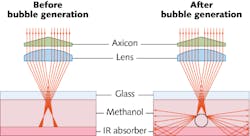Concentrating solar photovoltaic (PV) systems cut system costs by reducing the area of PV cells for a specified electrical output, but the precise mechanical tracking systems needed to keep a concentrator aimed at the sun can raise the system cost, to little advantage. As a result, researchers are looking at nonmechanical ways to finely track the sun (coarse tracking could still be left to a lower-cost mechanical tracker).
A group at the École Polytechnique Fédérale de Lausanne (Lausanne, Switzerland) has developed an optofluidic waveguide coupling mechanism in which focused light heats liquid in a waveguide to form a bubble of vapor that scatters the incoming sunlight into the waveguide, which carries the light to a concentrating PV cell. The experimental efficiency of a system coupling laser light through an off-the-shelf axicon lens pair into a methanol-containing waveguide was greater than 40%. Two lasers were used: one emitting at 460 nm to represent the visible part of the solar spectrum, and an infrared (IR) laser diode to simulate the IR spectral portion. When focused on the IR-absorbing glass that helps form the waveguide, the light produces a bubble that varies between 160 and 300 μm in diameter for IR power between 40 and 100 mW. The bubble-tracking technique could reach at least 90% efficiency with better optics, say the researchers. Contact Volker Zagolla at [email protected].
